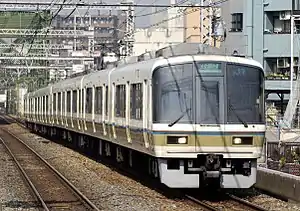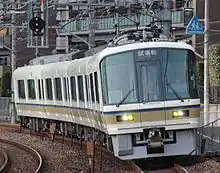| 221 series | |
|---|---|
 A 221 series formation in March 2008 | |
| Manufacturer |
|
| Built at | Kobe, Yonago, Kudamatsu, Higashiōsaka |
| Family name | Amenity Liner |
| Replaced | 113 series, 117 series, 201 series |
| Constructed | 1989–1992 |
| Entered service | March 1989 |
| Refurbished | 2012–2020 |
| Number built | 474 vehicles |
| Number in service | 474 vehicles |
| Formation | 2/4/6/8 cars per trainset |
| Operators | JR-West |
| Depots | Aboshi, Nara, Kyoto |
| Lines served | |
| Specifications | |
| Car body construction | Steel |
| Car length | 20,000 mm (65 ft 7 in) |
| Width | 2,950 mm (9 ft 8 in) |
| Doors | 3 pairs per side |
| Maximum speed | 120 km/h (75 mph) |
| Traction system | Resistor control + field system superimposed field excitation control |
| Traction motors | WMT61S WMT64S |
| Electric system(s) | 1,500 V DC overhead line |
| Current collector(s) | WPS27 scissors-type pantograph |
| Braking system(s) | Regenerative brake, electronically controlled pneumatic brakes, snow-resistant brake |
| Safety system(s) | ATS-P, ATS-SW |
| Coupling system | Shibata-Type |
| Multiple working | 223/225 series |
| Track gauge | 1,067 mm (3 ft 6 in) |
The 221 series (221系, 221-kei) is a suburban electric multiple unit (EMU) train type operated by West Japan Railway Company (JR-West) in the Kansai Region of Japan since March 1989.[1][2]
Operations
- Tōkaidō Main Line (Biwako Line, JR Kyoto Line, JR Kobe Line) (Maibara - Kōbe, until 2023)
- Sanyō Main Line (JR Kobe Line) (Kōbe - Kamigōri, until 2023)
- Hokuriku Main Line (Biwako Line) (Nagahama - Maibara, until 2023)
- Kosei Line (Yamashina - Ōmi-Imazu)
- Osaka Loop Line (only on Rapid service, Regional Rapid service and Local train)
- Osaka Higashi Line (from 12 March 2022)[3]
- Kansai Main Line (Yamatoji Line) (Kamo - JR Namba)
- Nara Line
- Sakurai Line (Manyō-Mahoroba Line)
- Wakayama Line (Ōji - Gojō)
- Akō Line (Aioi - Banshū-Akō, until 2023)
- Sanin Main Line (Sagano Line) (Kyoto - Fukuchiyama)
- Bantan Line (Himeji - Teramae, until 2023)
Formations
As of 1 October 2012, the fleet consisted of 474 vehicles, formed as 2-, 4-, 6-, and 8-car sets, based at Kyoto, Nara, and Aboshi depots.[4]
Aboshi Depot
8-car sets (A prefix)
| Car No. | 1 | 2 | 3 | 4 | 5 | 6 | 7 | 8 |
|---|---|---|---|---|---|---|---|---|
| Designation | Tc | T' | M1 | T' | M1 | T | M' | Mc |
| Numbering | KuHa 221 | SaHa 220 | MoHa 220 | SaHa 220 | MoHa 220 | SaHa 221 | MoHa 221 | KuMoHa 221 |
6-car sets (B prefix)
| Car No. | 1 | 2 | 3 | 4 | 5 | 6 |
|---|---|---|---|---|---|---|
| Designation | Tc | T' | M1 | T | M' | Mc |
| Numbering | KuHa 221 | SaHa 220 | MoHa 220 | SaHa 221 | MoHa 221 | KuMoHa 221 |
4-car sets (C prefix)
| Car No. | 1 | 2 | 3 | 4 |
|---|---|---|---|---|
| Designation | Tc | T | M' | Mc |
| Numbering | KuHa 221 | SaHa 221 | MoHa 221 | KuMoHa 221 |
Nara Depot
8-car sets (NB prefix)
| Car No. | 1 | 2 | 3 | 4 | 5 | 6 | 7 | 8 |
|---|---|---|---|---|---|---|---|---|
| Designation | Tc | T' | M1 | T' | M1 | T | M' | Mc |
| Numbering | KuHa 221 | SaHa 220 | MoHa 220 | SaHa 220 | MoHa 220 | SaHa 221 | MoHa 221 | KuMoHa 221 |
6-car sets (NC prefix)
| Car No. | 1 | 2 | 3 | 4 | 5 | 6 |
|---|---|---|---|---|---|---|
| Designation | Tc | T' | M1 | T | M' | Mc |
| Numbering | KuHa 221 | SaHa 220 | MoHa 220 | SaHa 221 | MoHa 221 | KuMoHa 221 |
4-car sets (NA prefix)
| Car No. | 1 | 2 | 3 | 4 |
|---|---|---|---|---|
| Designation | Tc | T | M' | Mc |
| Numbering | KuHa 221 | SaHa 221 | MoHa 221 | KuMoHa 221 |
| Designation | Tc' | M1 | T | Mc1 |
| Numbering | KuHa 220 | MoHa 220 | SaHa 220 | KuMoHa 220 |
2-car sets
| Car No. | 1 | 2 |
|---|---|---|
| Designation | Tc' | Mc1 |
| Numbering | KuHa 220 | KuMoHa 220 |
Kyoto Depot
4-car sets (K prefix)
| Car No. | 1 | 2 | 3 | 4 |
|---|---|---|---|---|
| Designation | Tc | T | M' | Mc |
| Numbering | KuHa 221 | SaHa 221 | MoHa 221 | KuMoHa 221 |
The KuMoHa 221 cars in some formations are equipped with a second de-icing pantograph.
Interior
Seating is arranged as 2+2 abreast transverse flip-over seats.
 The seat in a 221 series train
The seat in a 221 series train Original interior style in May 2009
Original interior style in May 2009.jpg.webp) Interior of a refurbished train
Interior of a refurbished train.jpg.webp) Original LED passenger information display in September 2005
Original LED passenger information display in September 2005.jpg.webp) LED passenger information display of a refurbished train in October 2014
LED passenger information display of a refurbished train in October 2014.jpg.webp) Wheelchair-accessible toilet of a refurbished train
Wheelchair-accessible toilet of a refurbished train
History
The first 221 series trains were introduced from the start of the revised timetable in March 1989.[2]
The 221 series received the Laurel Prize in 1990.[5]
Refurbishment

From December 2012, a programme of refurbishment started, which will ultimately cover the entire fleet of 474 vehicles.[6] Interior improvements include new universal access toilets, provision of wheelchair spaces, and flip-up seating next to the doorways.[6] The first refurbished set, 4-car set K12, was returned to revenue service on 11 January 2013.[7]
References
- ↑ Haraguchi, Takayuki (2009). Jr全車両: ビジュアル決定版 Encyclopedia of JR's Railway Cars: JR全車輌. Japan: Sekai Bunka. p. 79. ISBN 978-4-418-09905-4.
- 1 2 Jēāru zensharyō handobukku: Rail Magazine 2009 JR全車輌ハンドブック2009 [JR Rolling Stock Handbook 2009]. Japan: Neko Publishing. 2009. pp. 271–272. ISBN 978-4-7770-0836-0.
- ↑ "おおさか東線で221系の運用開始" [221 series starts operation on the Osaka Higashi Line]. Japan Railfan Magazine Online (in Japanese). Japan: Koyusha Co., Ltd. 12 March 2022. Retrieved 12 March 2022.
- ↑ Jr電車編成表 2013冬 JR電車編成表 2013冬 [JR EMU Formations - Winter 2013]. Japan: JRR. November 2012. p. 406. ISBN 978-4-330-33112-6.
- ↑ ブルーリボン賞・ローレル賞 選定車両一覧 [Blue Ribbon & Laurel Prize Winners List]. jrc.gr.jp (in Japanese). Japan: Japan Railfan Club. 29 May 2012. Archived from the original on 26 October 2010. Retrieved 9 January 2013.
- 1 2 221系近郊型電車のリニューアルについて [221 series outer-suburban EMU refurbishment] (Press release) (in Japanese). West Japan Railway Company. 8 January 2013. Retrieved 8 January 2013.
- ↑ 221系リニューアル車が営業運転を開始 [Refurbished 221 series in revenue service]. Japan Railfan Magazine Online (in Japanese). Japan: Koyusha Co., Ltd. 13 January 2013. Retrieved 13 January 2013.